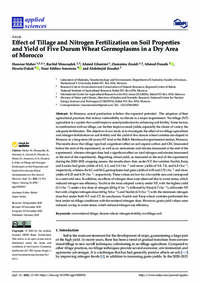Effect of Tillage and Nitrogen Fertilization on Soil Properties and Yield of Five Durum Wheat Germoplasms in a Dry Area of Morocco

Authors:
In Morocco, cereal production is below the expected potential. The adoption of best
agricultural practices that reduce vulnerability to climate is a major requirement. No-tillage (NT)
agriculture is a system that could improve cereal production by enhancing soil fertility. Some factors,
in combination with no-tillage, can further improve cereal yields, especially the choice of variety the
adequate fertilization. The objective of our study is to investigate the effect of no-tillage agriculture
and nitrogen fertilization on soil fertility and the yield of five durum wheat varieties developed in
Morocco in a long-term (18 years) NT trial at the INRA Merchouch experimental station, Morocco.
The results show that tillage type had a significant effect on soil organic carbon and CEC (measured
before the start of the experiment), as well as on ammonium and nitrates (measured at the end of the
experiment), whereas nitrogen dose had a significant effect on total nitrogen and nitrates (measured
at the end of the experiment). Regarding wheat yield, as measured at the end of the experiment
during the 2020–2021 cropping season, the results show that, under NT, the varieties Nachit, Faraj,
and Louiza had grain yields of 4.5, 4.3, and 3.4 t ha−1 and straw yields of 9.8, 7.8, and 6.8 t ha−1
,respectively, whereas the I.C and M.G germoplasms had grain yields of 4.05 and 3.72 t ha−1 and straw yields of 8.25 and 8.39 t ha−1 , respectively. These values are low for a favorable area and correspond to a semi-arid area. In addition, no effects of nitrogen dose were observed due to water stress, which reduced nitrogen use efficiency. Nachit is the most adapted variety under NT, with the highest yield(5.1 t ha−1) under a low dose of nitrogen (20 kg N ha−1), followed by Faraj (4.7 t ha−1), still under NTbut with a higher nitrogen dose (40 kg N ha−1) and Nachit (4.5 t ha−1)with the minimum nitrogen dose but under both NT and CT. In conclusion, Nachit and Faraj wheat varieties performed thebest under no-tillage conditions with the minimal nitrogen dose. However, grain yield values were reduced, owing to water stress, which reduced nitrogen use efficiency.
